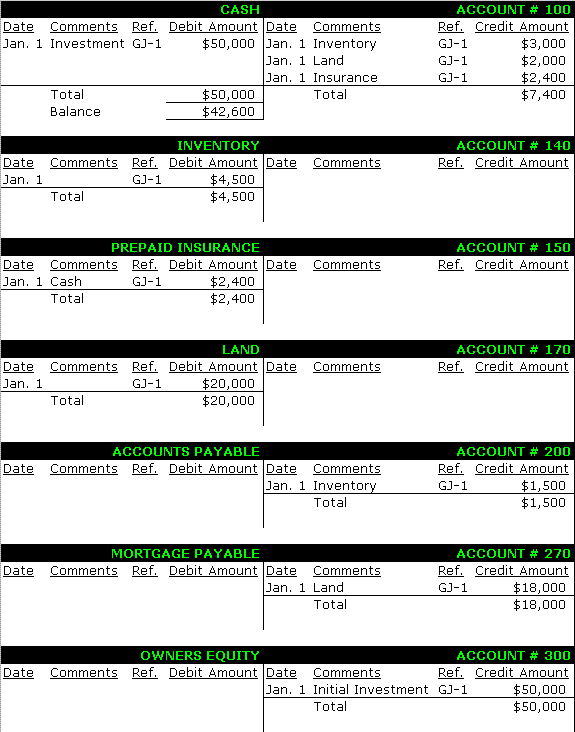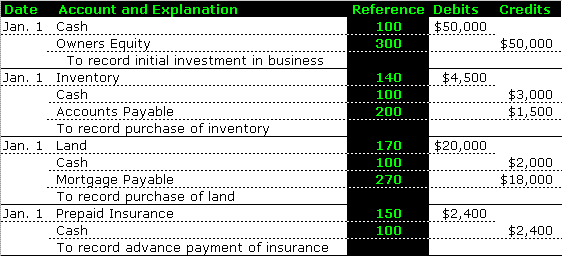The General Ledger
The General Ledger
| The next step in the accounting cycle is to post the accounting entries made in the accounting journal to the general ledger. |
The following general ledger accounts use Sunny Sunglasses Shop’s chart of accounts to classify each posting by account number.
Let’s continue our example by posting the four transactions in the accounting journal into the accounting ledger.
General Ledger Accounting
As a quick recap, the following transactions occurred on January 1, 2010 to start Sunny Sunglasses Shop:
- Jan. 1 Sunny invested $50,000 into his new business, Sunny Sunglasses Shop.
- Jan. 1 Purchased inventory for $4,500. Paid $3,000 cash, with the balance of $1,500 due in 90 days.
- Jan. 1 Purchased land for $20,000 with $2,000 as a down payment, and a 15 year mortgage for $18,000.
- Jan. 1 Purchased insurance for the year for $2,400.
The above events are posted to the accounting ledger from the accounting journal as follows:
Sunny Sunglasses Shop
Ledger Accounting
General Ledger Accounts after Posting from the Accounting Journal
Notice that the general ledger is a summary of each account. General ledger accounts are also called “T-Accounts” because of the appearance of the letter T.
Ledger Accounting and Double Entry Accounting
Both the general ledger accounts and the accounting journal use double entry accounting to keep the accounting equation in balance. The general ledger show each accounting entry in separate general ledger accounts for a summary of each account. Adding the columns for each account and taking the difference between the two columns equals the balance of the account. For example, the debit column of cash totals $50,000, and the credits total $7,400. The difference between the two equals $42,600. If we take the time to tally up the accounts at this point, the accounting equation remains in balance:
| Assets | = Liabilities | + Owner’s Equity |
| $69,500 | = $19,500 | + $50,000 |
The main general ledger account numbers, also listed in the chart of accounts, appear on the right side of each account. Each general ledger account references the source from which the transaction was posted. For example, “GJ-1” means that the accounting entry was posted from the first page of the accounting journal.
Similarly, the accounting journal now references the general ledger accounts in the reference column to show where the accounting entry was posted in the general ledger, which completes the posting for the general journal below.
From Ledger Accounting to the Fourth Step in the Accounting Cycle: The Unadjusted Trial Balance
Back to the Online Accounting Main Page



Thank you, Jasiel!
WONDERDFUL LESSON
Quite helpful